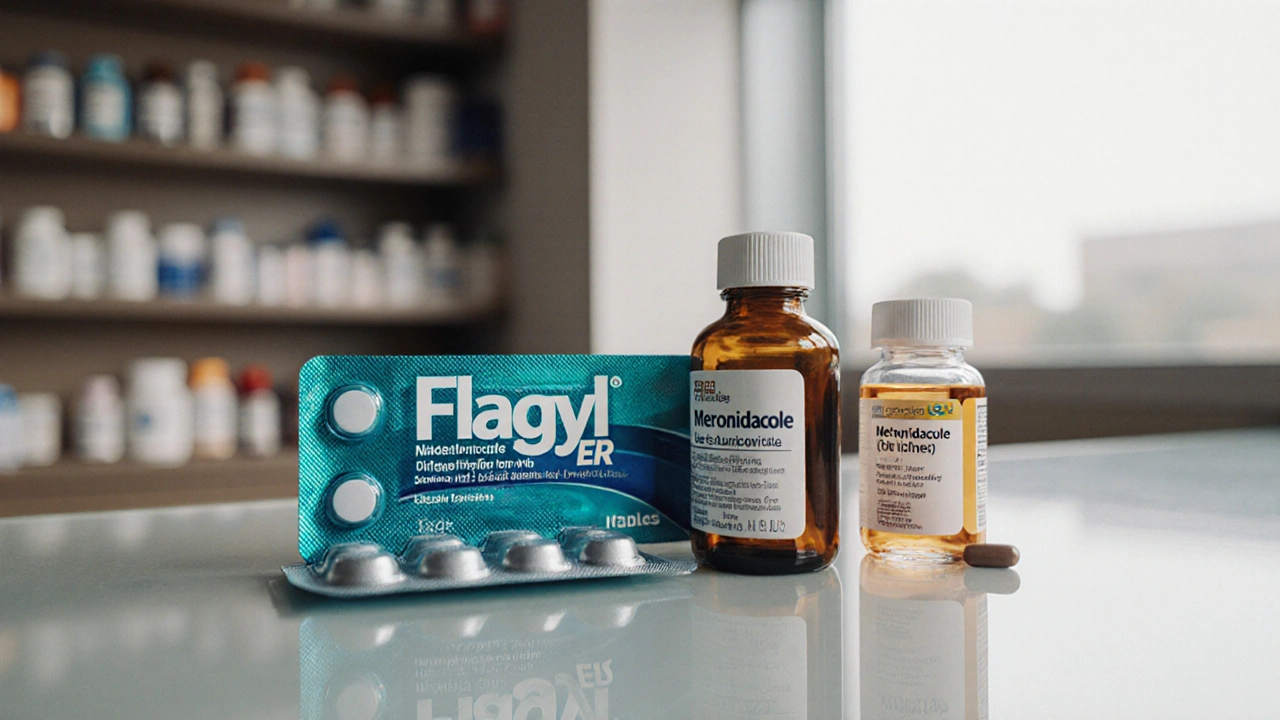Flagyl ER vs Alternative Antibiotics Comparison Tool
| Drug | Class | Typical Regimen | Key Indications | Side Effects | Cost Tier |
|---|
Key Takeaway:
Use the filters above to see how different antibiotics compare based on your specific needs. For example, tinidazole and secnidazole offer single-dose convenience, while Flagyl ER provides once-daily dosing for longer treatments.
If you’ve been prescribed Flagyl ER and are wondering whether another pill might work just as well-or even better-this guide breaks down the facts. We’ll look at how Flagyl ER stacks up against the most common alternatives, explain the key factors you should consider, and give you clear takeaways for choosing the right drug for your infection.
What is Flagyl ER?
Flagyl ER is the brand name for an extended‑release formulation of metronidazole, a nitroimidazole antibiotic that targets anaerobic bacteria and certain parasites. The “ER” stands for “Extended Release,” meaning the tablet dissolves slowly, providing a steady drug level for up to 24 hours.
Key attributes:
- FDA approval year: 1995 (original immediate‑release version), extended‑release introduced in 2002.
- Typical dose: 750mg once daily for most infections.
- Half‑life: Approximately 8hours, but the ER matrix extends effective exposure.
How does Flagyl ER work?
The drug enters bacterial cells, where it is reduced by ferredoxin‑like proteins. This reduction creates toxic radicals that damage DNA, leading to cell death. Because it targets anaerobes, Flagyl ER is especially useful for infections where oxygen‑free environments thrive, such as dental abscesses, intra‑abdominal infections, and certain gynecologic conditions.
When is Flagyl ER prescribed?
Doctors often choose Flagyl ER for:
- Bacterial vaginosis and trichomoniasis (single‑dose regimens).
- Pelvic inflammatory disease (PID) involving anaerobic organisms.
- Complicated intra‑abdominal abscesses.
- Clostridioides difficile‑associated diarrhea (adjunct therapy).
Its once‑daily schedule improves adherence compared with the immediate‑release version which requires dosing two to three times a day.
Criteria to compare antibiotics
When you line up Flagyl ER against other options, keep these factors in mind:
- Spectrum of activity: Does the drug cover the bacteria or parasites you’re fighting?
- Dosing frequency: Fewer pills usually mean better compliance.
- Side‑effect profile: Nausea, metallic taste, disulfiram‑like reactions, etc.
- Cost and insurance coverage: Extended‑release brands can be pricier.
- Resistance trends: Some regions report rising metronidazole resistance.
- Formulation convenience: Oral vs IV vs topical, need for food restrictions.
Top alternatives to Flagyl ER
Below are the most commonly considered substitutes, each with its own strengths and drawbacks.
- Tinidazole is a nitroimidazole similar to metronidazole but typically given as a single 2g oral dose for trichomoniasis and bacterial vaginosis. It has a longer half‑life (≈13hours) and fewer dosing events.
- Secnidazole is another nitroimidazole approved for a single 2g dose in bacterial vaginosis. Its half‑life exceeds 17hours, making it the most convenient single‑dose option.
- Clindamycin is a lincosamide antibiotic that covers many Gram‑positive and anaerobic organisms. It’s often prescribed for pelvic infections when metronidazole cannot be used.
- Metronidazole immediate‑release (standard Flagyl) requires 500-750mg two to three times daily, offering the same antimicrobial activity but higher pill burden.
- Metronidazole IV is reserved for severe intra‑abdominal or bloodstream infections where oral absorption might be compromised.
- Doxycycline is a tetracycline antibiotic with broad coverage, useful for some sexually transmitted infections but lacking strong anaerobic activity.

Comparison table
| Drug | Class | Typical Regimen | Key Indications | Side‑effect Highlights | Cost Tier (US) |
|---|---|---|---|---|---|
| Flagyl ER | Nitroimidazole (extended‑release) | 750mgoncedaily | Bacterial vaginosis, PID, intra‑abdominal abscess | Nausea, metallic taste, disulfiram‑like reaction | $$$ |
| Tinidazole | Nitroimidazole | 2gsingledose | Trichomoniasis, bacterial vaginosis | Headache, metallic taste, mild GI upset | $$ |
| Secnidazole | Nitroimidazole | 2gsingledose | Bacterial vaginosis (single‑dose option) | GI upset, rare hypersensitivity | $$ |
| Clindamycin | Lincosamide | 300mgfourtimesdaily | Anaerobic skin infections, PID (alternative) | Diarrhea, C.difficile risk | $$ |
| Metronidazole (IR) | Nitroimidazole (immediate‑release) | 500-750mg2‑3timesdaily | Same as Flagyl ER but higher pill count | Similar to ER, more GI upset due to dosing frequency | $$ |
| Metronidazole IV | Nitroimidazole (intravenous) | 15mg/kgevery6hours | Severe intra‑abdominal, septic shock | Phlebitis, metallic taste, nausea | $$$$ |
| Doxycycline | Tetracycline | 100mgtwicedaily | Chlamydia, acne, some STI prophylaxis | Photosensitivity, esophageal irritation | $$ |
Pros and cons of Flagyl ER
Pros
- Once‑daily dosing improves adherence, especially for long‑term regimens.
- Steady plasma levels reduce peaks that can trigger nausea.
- Proven efficacy for a wide range of anaerobic infections.
Cons
- Higher out‑of‑pocket cost compared with generic metronidazole tablets.
- Same disulfiram‑like reaction risk when mixed with alcohol.
- Not suitable for patients with severe hepatic impairment (dose adjustment needed).
Which alternative fits which scenario?
Single‑dose convenience: If you hate taking pills every day, tinidazole or secnidazole wins. Both deliver the full course in one swallow, making them ideal for uncomplicated bacterial vaginosis or trichomoniasis.
Severe intra‑abdominal infection: IV metronidazole provides rapid high‑level exposure when oral absorption is unreliable. Pair it with broad‑spectrum agents for polymicrobial coverage.
Allergy or intolerance to nitroimidazoles: Switch to clindamycin. It covers many anaerobes and can be given IV or oral, but watch for C.difficile risk.
Cost‑sensitive patients: Generic metronidazole immediate‑release is cheap and effective, though you’ll need to take it two or three times a day.
Broad‑spectrum need beyond anaerobes: Doxycycline adds coverage for atypical organisms and some STIs, but it won’t replace metronidazole for anaerobic bugs.
Practical tips for using Flagyl ER or its alternatives
- Take the tablet with food or a full glass of water to reduce stomach upset.
- Avoid alcohol completely for 48hours after the last dose to prevent a disulfiram‑like reaction.
- If you miss a dose, take it as soon as you remember-unless it’s close to the next scheduled dose, then skip the missed one.
- Complete the full prescribed course, even if symptoms improve early. Stopping early can foster resistance.
- Notify your doctor if you develop severe nausea, dark urine, or signs of liver trouble (jaundice, itching).
Bottom line
Flagyl ER shines when you need reliable anaerobic coverage with minimal daily dosing. Its main trade‑off is price. If convenience or budget tops your list, tinidazole, secnidazole, or generic metronidazole tablets are solid choices-just match the drug to the infection type and your personal situation.
Frequently Asked Questions
Can I take Flagyl ER with alcohol?
No. Flagyl ER (metronidazole) can cause a severe disulfiram‑like reaction if you drink alcohol within 48hours of the last dose. Symptoms include flushing, rapid heart rate, nausea, and vomiting.
Is a single dose of tinidazole as effective as a full course of Flagyl ER?
For uncomplicated bacterial vaginosis and trichomoniasis, studies show a 2‑gram dose of tinidazole has cure rates comparable to a 7‑day course of metronidazole. However, for deeper intra‑abdominal infections, longer courses are still recommended.
What are the main side effects of Flagyl ER?
Common side effects include nausea, metallic taste, loss of appetite, and occasional headache. Rare but serious reactions involve liver toxicity, peripheral neuropathy, and severe skin rash.
When should I choose IV metronidazole over oral Flagyl ER?
IV administration is preferred for patients who cannot tolerate oral meds, have intestinal malabsorption, or are critically ill with sepsis where rapid high serum levels are needed.
Is clindamycin a safe alternative for patients allergic to metronidazole?
Clindamycin works well against many anaerobes, but it carries a higher risk of C.difficile infection. Discuss with your clinician to weigh benefits versus gut‑flora concerns.






13 Comments
Choosing the right antibiotic is not just a medical decision it is a civic duty to protect our community health. The extended‑release formulation of metronidazole offers a compliance advantage that translates into public health benefits.
From a grammatical standpoint the table you provided is well‑structured, but a brief note on dosing frequency could improve readability. Adding a colon after each heading would make the list even clearer.
If you’re looking for a simple way to remember the schedule think of Flagyl ER as a once‑daily habit like a morning coffee. It cuts down pill burden which means fewer missed doses and better outcomes. Pair it with food and you’ll likely feel less nausea.
Another endless spreadsheet of drugs-so dramatic it could put a snail to sleep.
Got my prescription for Flagyl ER and I’m already feeling the steady release vibe 😊 It’s a solid choice for those who hate multiple daily pills.
I hear the point about compliance and I agree 👍 The once‑daily schedule really does make a difference for busy folks.
While the preceding remarks are syntactically adequate, they suffer from a paucity of lexical sophistication. One might elevate the discourse by invoking terms such as “pharmacokinetic optimisation” rather than merely “once‑daily”. Moreover, the tabular data could benefit from an artisanal shade of cerulean to demarcate the cost hierarchy, thereby marrying form to function.
Let me spin a thread of thought around the whole metronidazole family and its extended‑release cousin, Flagyl ER. The molecule itself is a classic nitro‑imidazole, the kind that loves anaerobic niches, but the ER matrix turns it into a marathon runner rather than a sprinter. It’s like swapping a short‑burst sprint for a steady jog, which in pharmacology translates to more stable plasma concentrations and ultimately less peaks that can trigger that nasty metallic taste. In the grand tapestry of antibiotics, this steadiness is a virtue, especially when treating hidden pelvic infections where adherence is the Achilles’ heel.
Now, compare that to tinidazole, which boasts a single 2‑gram pill and a longer half‑life. The convenience is undeniable, yet the pharmacodynamic profile still hinges on a high peak, which can sometimes be a double‑edged sword for tolerability. Secnidazole follows the same single‑dose ethos, pushing the half‑life even further, but it lacks the breadth of indications that Flagyl ER covers, particularly deep intra‑abdominal abscesses.
Then there’s the classic immediate‑release metronidazole tablets. They’re cheap, they work, but they demand three doses a day – a regimen that turns compliance into a chore. The more frequent dosing leads to repeated spikes in blood levels, often correlating with increased nausea and gastrointestinal upset. The IV form, while pricey, is reserved for the critically ill where oral absorption is compromised; its constant infusion delivers a relentless assault on pathogens but at a cost both financial and logistical.
Clindamycin enters the arena as a lincosamide, covering many Gram‑positive organisms and anaerobes alike, yet it waddles in with a higher risk of C. difficile colitis – a trade‑off that clinicians must weigh carefully. Doxycycline, though a broad‑spectrum tetracycline, simply does not hit the anaerobic sweet spot that metronidazole derivatives dominate.
In practice, the decision tree looks like this: if you need a one‑off convenience for uncomplicated BV or trich, go tinidazole or secnidazole. If the infection is deep‑seated, long‑term, or you anticipate adherence challenges, Flagyl ER shines. If cost is the primary barrier, generic immediate‑release metronidazole remains a solid workhorse, provided the patient can handle the dosing schedule. And when you’re stuck with a metronidazole allergy, clindamycin becomes the fallback, with the caveat of vigilant monitoring for gut flora disruption.
Bottom line: the extended‑release format is not just a marketing gimmick; it is a pharmacokinetic strategy designed to align drug exposure with patient lifestyle, thereby reducing the likelihood of resistance emergence and improving therapeutic outcomes.
Hey everyone let’s get fired up about making the right choice! The extended‑release pill is a game‑changer for those who hate juggling meds. If you’re on a budget remember the generic IR version still does the job – just be ready to take it 2‑3 times a day. Keep pushing for the regimen that fits your life!
Just sitting back and watching the discussion – love seeing the mix of science and personal experience. It’s cool how each option has its own vibe.
Thanks for the thorough breakdown! I think the key is matching the drug to the infection and the user’s ability to stick with the schedule. Flagyl ER definitely helps those who struggle with multiple doses.
Stop treating cheap drugs like a status symbol.
I hear a lot of solid points here and I appreciate the balanced view – especially the reminder to finish the full course no matter how good you feel.